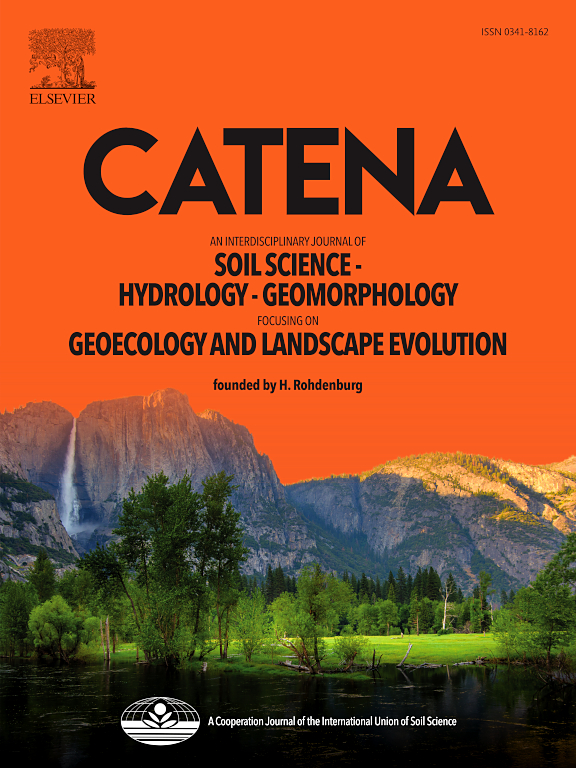The potential effect of temperature on surface deformation after water drop impact in soils with different texture and moisture content
IF 5.7
1区 农林科学
Q1 GEOSCIENCES, MULTIDISCIPLINARY
引用次数: 0
Abstract
The splash phenomenon occurs when water drops hit the soil surface, making it the initial stage of most types of soil erosion caused by water. An effect of this phenomenon, in addition to the detachment and displacement of soil particles, is also the deformation of the soil surface. Climate change (including the occurrence of periods of very high temperatures) can affect the intensity of soil erosion processes. The aim of this work is to determine the influence of selected temperature conditions on soil surface deformation caused by the splash phenomenon at the initial stage of erosion. The goal was achieved by measuring the morphology of craters formed by the impact of a single drop. The research included the use of three soils varying in particle size distribution: loamy sand, sandy loam, and silty loam. Additionally, the work took into account two variants of initial soil moisture and three temperature conditions (including various temperatures of soil, air, and drop-forming water). The measurements were taken with a 3D scanner, determining depth, equivalent diameter, volume of the craters, and a dimensionless parameter α (depth-to-diameter ratio). Temperature effects were observed in silty loam, where craters became wider (from average diameter of 9.41 ± 0.31 to 10.47 ± 0.21 mm for pF = 1) but shallower (from average depth of 1.28 ± 0.05 to 1.00 ± 0.05 mm for pF = 1) with increasing temperature, and in loamy sand, where temperature influenced the differences in diameter and volume of craters formed between varying moisture conditions. The differences in crater morphology could be due to the influence of temperature on the viscosity and surface tension of water, which may have led to a change in susceptibility to deformation. The results provide an opportunity to better understand the evolution of erosion in the context of different thermal conditions and thus in some perspective on the impact of climate change.
温度对不同质地和含水量土壤中水滴冲击后表面变形的潜在影响
水花现象发生在水滴撞击土壤表面时,这是大多数类型的水土流失的初始阶段。这种现象的一个影响,除了土壤颗粒的脱离和位移,也是土壤表面的变形。气候变化(包括高温期的出现)会影响土壤侵蚀过程的强度。本工作的目的是确定所选温度条件对侵蚀初始阶段飞溅现象引起的土壤表面变形的影响。这一目标是通过测量单滴撞击形成的陨石坑的形态来实现的。该研究包括使用三种不同粒度分布的土壤:壤土、砂质壤土和粉质壤土。此外,该工作考虑了初始土壤湿度的两种变化和三种温度条件(包括土壤、空气和水滴形成水的不同温度)。使用3D扫描仪进行测量,确定深度,等效直径,陨石坑体积和无量纲参数α(深度-直径比)。在粉质壤土中观察到温度效应,随着温度的升高,陨石坑变得更宽(pF = 1时,从平均直径9.41±0.31 mm到10.47±0.21 mm),而更浅(pF = 1时,从平均深度1.28±0.05 mm到1.00±0.05 mm);在壤土砂中,温度影响不同湿度条件下形成的陨石坑直径和体积的差异。陨石坑形态的差异可能是由于温度对水的粘度和表面张力的影响,这可能导致变形敏感性的变化。这些结果为更好地了解不同热条件下侵蚀的演变提供了机会,从而从某种角度了解气候变化的影响。
本文章由计算机程序翻译,如有差异,请以英文原文为准。
求助全文
约1分钟内获得全文
求助全文
来源期刊

Catena
环境科学-地球科学综合
CiteScore
10.50
自引率
9.70%
发文量
816
审稿时长
54 days
期刊介绍:
Catena publishes papers describing original field and laboratory investigations and reviews on geoecology and landscape evolution with emphasis on interdisciplinary aspects of soil science, hydrology and geomorphology. It aims to disseminate new knowledge and foster better understanding of the physical environment, of evolutionary sequences that have resulted in past and current landscapes, and of the natural processes that are likely to determine the fate of our terrestrial environment.
Papers within any one of the above topics are welcome provided they are of sufficiently wide interest and relevance.
 求助内容:
求助内容: 应助结果提醒方式:
应助结果提醒方式:


